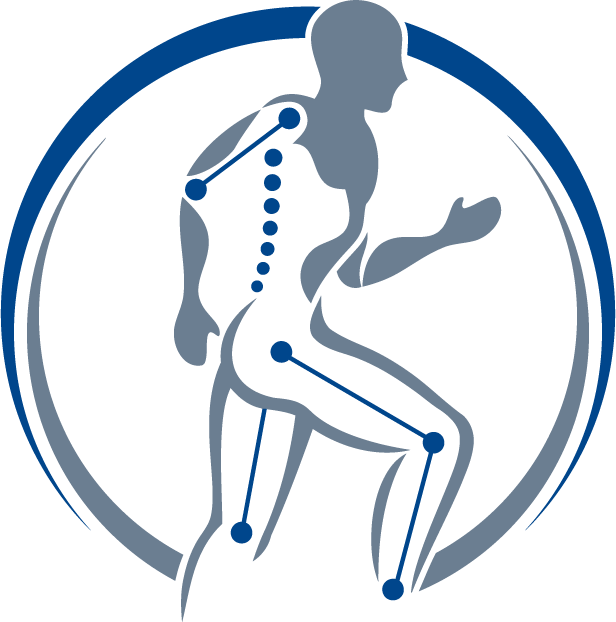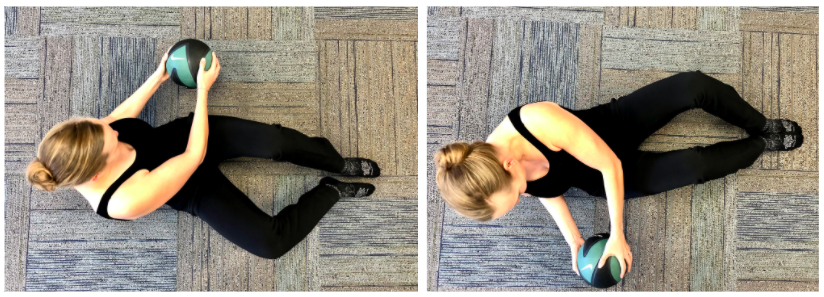What those with chiseled abs can learn from today’s PB instructor
While in fitness class today I heard great instruction on oblique strengthening. My instructor said “rotation should occur within the distance of the knees.” What a great cue!. Notice the image below - in one diagram rotation is occurring between the knees; in the other it’s occurring past the knees.
“Between the knees” rotation - notice the distance of the hands traveled.
“Past the knees” rotation - notice how the hands travel a distance past the knees.
To illustrate why this “between the knees” rotation is so valuable, I have to take you back many years to my youth. I grew up as a highly motivated swimmer. Often after practice, I would hang horizontally off the edge of the top bleachers with an 8 lb medicine ball and complete lumbar rotation exercises. I would allow the ball (& gravity) to drag me to one side and then use my abdominals to rotate quickly in the other direction. In this motion, you can imagine how the med ball and gravity would drag the spine past the end range of motion. It was a strenuous version of the “Russian Twist” in the image below.
Today, and after my C-section last year, there is no way I could demonstrate this bleacher exercise. But, you can imagine that with both acceleration and gravity acting, my spine was moving to an extreme If done poorly, this Russian twist exercise will also have the same effect of moving the spine past it’s end range. As I write this blog, I am reflecting on those tens of thousands of rotations I did, and it makes me cringe (and hastily fix my sitting posture). That is because I now know that extremes of rotation cause shearing between the vertebrae of the low back that was compromising the health of my spine.
Our body is built in alternating stable and mobile segments. In general we want to improve stability of the ‘stable segments’ and improve mobility of the ‘mobile segments’. When we break down and allow our mobile segments to get stiff, it forces our stable segments to move too easily. The lumbar spine is sandwiched between two mobile segments, the thoracic spine (our primary source of rotation in our spine/ torso) and the hip joint (that also allows for rotation as a ball and socket joint). The lumbar spine (low back) is designed as a stable segment, not as a rotational (or mobile) segment.
You can see in the image below that the orientation of the facets (those vertical pointy bones on the vertebra) interlock, allowing only minimal rotation between the segments.
If the lumbar spine doesn't rotate much, how did I get into those end range postures with the med ball? Shearing. Notice the diagram below. When you push the lumbar spine past the point of natural rotation (for example with a med ball), you create a shearing between the vertebrae, where one vertebrae slides sideways on top of the other. At this point you begin to rotate around the interlocking joints.
Remember there is a disc between those vertebrae. That disc undergoes the shearing force. This shearing breaks down fibers in the disc and contributes to disc degeneration over time. As the discs degenerate, they lose height and leave less space for the nerves. While disc degeneration is a normal part of aging, we want to mitigate activities that would increase the rate of degeneration. Activities that actively shear the joint to end range logically would contribute to accelerating that ageing process.
But I know lots of people with great abs that do a lot of lumbar rotation exercises -their backs are fine! Indeed, while you are strong, active and healthy you may never notice a problem. But add on a few decades of less than ideal motion quality- extra late nights at work, caregiving for a family member, or bringing a few kids into the world and we start to notice those problems we created over years of peak fitness while we ignored the natural limits of our spine.
So should I avoid rotation? No! The thoracic spine rotates nicely, the hips rotate nicely (or should) and if you focus on moving with good quality patterns, you will avoid excessively rotating the lumbar spine. The key word here is excessive. As long as you are moving into positions that your muscles can (slowly and in a controlled way) move you into, you will not be forcing your joints into any movements that are problematic. Additionally, many sports that we love require rotation, such as golf, tennis. As you know, those who rotate well in their upper back and hips generally have better results and fewer aches at the low back and knees.
How much rotation is okay? Notice the rotation yoga pose below. In both green examples the rotation is created from the abdominals. In the left picture the arms are used to create overpressure forcing the joints to end range, this is effectively the same as using the med ball, adding an extra, unnecessary force to create rotation in your low back. The first form of rotation is just fine, the left overpressure rotation is not ideal.
Can I use the med ball still? Our favorite answer: it depends. How is your body awareness? You need to be specific about your movements, particularly as you fatigue. Move the ball only within the ranges that your body allows.
If you are not sure if you are moving in a healthy pattern for your spine, or struggle with low back pain, please reach out to us. We can help you to understand your unique joint structure and learn how to continue participating in the activities you love in ways that are best for your body.
To your movement health,
Ann (& Jesse)
This blog is not intended as medical or professional advice. The information provided is for educational purposes only and is not intended to serve as medical or physical therapy advice to any individual. Any exercise has potential to cause injury or pain if it is incorrectly done or is not the right exercise for an individual’s medical or physical problems. You should consult with a physical therapist or medical provider for individualized advice.








